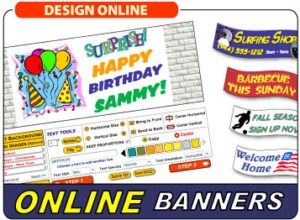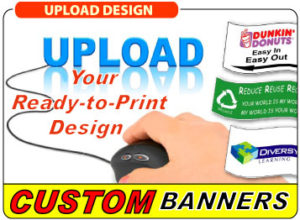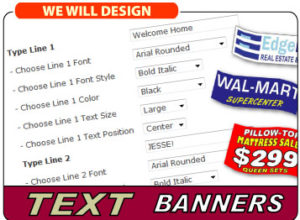| Hi-Quality Digitally Printed & Shipped in 1 Day | Indoor/Outdoor Use up to 3 Years | ||
| Premium 13 ounce Vinyl Banner Material | Waterproof & UV Protected |
All Banner Categories
-

Online Banners
-

Custom Banners
-

Text Banners
-

Anniversary Banners
-

Congratulation Banners
-

Retirement Banners
-

4th of July Banners
-

Christmas Banners
-

Easter Banners
-

Grand Opening Banners
-

Memorial Day Banners
-

Custom Retail / Business Banners | Vinyl Banner Printing
-

St. Patrick's Day Banners
-

Thanksgiving Banners
-

Valentine's Banners
At 1 Day Banner, we understand that choosing the right banner for your needs can be overwhelming given the variety of options available. That’s why we’ve created this comprehensive guide to help you navigate through all the types, materials, printing techniques, design elements, uses, features, accessories, and maintenance tips related to banners. Whether you’re looking for a durable outdoor banner, a vibrant indoor display, or specialized banners for events, holidays, or promotions, this guide will provide you with all the information you need to make an informed decision.
[Click to read more/less of the Guide]
1. Banner Types
Material-Based Banners
- Canvas Banners: Textured and artistic, often used for high-quality prints.
- Eco-friendly Banners: Made from sustainable materials, catering to eco-conscious customers.
- Fabric Banners: Soft texture, often used for indoor events and trade shows.
- Mesh Banners: Perforated material allows wind to pass through, perfect for outdoor settings.
- Nylon Banners: Flexible and strong, ideal for outdoor use.
- Polyester Banners: Lightweight and durable, used for indoor and outdoor settings.
- PVC Banners: Strong and weather-resistant, suitable for various environments.
- Vinyl Banners: Durable and versatile, ideal for both indoor and outdoor use.
Please Note: We only sell VINYL BANNERS at the moment.
Function-Based Banners
- Backdrop Banners: Large backgrounds for stages, events, and photography.
- Billboard Banners: Large-scale banners for roadside advertising.
- Double-sided Banners: Printed on both sides, maximizing visibility.
- Feather Banners: Tall and attention-grabbing, great for outdoor advertising.
- Hanging Banners: Suspended from ceilings or structures, used for large displays.
- Indoor Banners: Specifically designed for indoor use with vibrant colors.
- Large Banners: Oversized banners for significant visual impact.
- Outdoor Banners: Specifically designed for outdoor use exposed to the elements.
- Photo/Picture Banners: Customized with high-resolution images, perfect for events.
- Pole Banners: Mounted on poles, ideal for street advertising and events.
- Popup Banners: Quick setup and takedown, used for trade shows and promotions.
- Retractable Banners: Portable and easy to set up, commonly used at trade shows and events.
- Single-sided Banners: Printed on one side, cost-effective for single-direction views.
- Small Banners: Compact size for targeted messaging.
- Step and Repeat Banners: Backdrops with repeating logos, used for photo ops and events.
- Street Banners: Displayed across streets, used for community events and announcements.
- Vertical Banners: Tall banners ideal for maximizing vertical space.
- Wall Banners: Mounted on walls for indoor and outdoor displays.
Color-Based Banners
- Black Banners: Elegant and professional, ideal for various occasions.
- Blue Banners: Calm and trustworthy, often used for corporate events.
- Brown Banners: Earthy and natural, perfect for organic or rustic themes.
- Gray Banners: Neutral and balanced, suitable for professional settings.
- Green Banners: Fresh and vibrant, great for eco-friendly events.
- Orange Banners: Bold and energetic, ideal for promotions and sales.
- Pink Banners: Fun and playful, perfect for celebratory events.
- Purple Banners: Regal and sophisticated, suitable for high-end events.
- Red Banners: Eye-catching and dynamic, great for attracting attention.
- White Banners: Clean and simple, versatile for any event.
- Yellow Banners: Bright and cheerful, excellent for festive occasions.
2. Banner Printing Techniques
- Digital Printing: High-quality prints with vivid colors and intricate details.
- Dye Sublimation: Produces rich, full-color prints with a soft feel.
- Heat Transfer Printing: Transfers designs onto banners using heat, suitable for custom graphics.
- Screen Printing: Cost-effective for large runs, with bold and vibrant colors.
- UV Printing: Durable prints resistant to fading from sunlight exposure.
Please Note: We use DIGITAL PRINTING to print all of our banners.
3. Banner Design Elements
- Color Selection: Choosing colors that attract attention and match branding.
- Custom Graphics: Tailored designs to meet specific branding needs.
- Font Styles: Selecting fonts that are readable and visually appealing.
- Image Resolution: Ensuring high-quality images for clear and sharp prints.
- Text Layout: Strategic placement of text for readability and impact.
4. Banner Uses
Celebrations
- Anniversary Banners: Celebrates anniversaries with custom messages.
- Baby Shower Banners: Themed banners for baby shower celebrations.
- Band & Music Banners: Promotes music events and band performances.
- Birthday Banners: Customized for birthday celebrations with personal messages.
- Celebration Banners: General use for various celebrations.
- Congratulation Banners: Used to congratulate achievements and milestones.
- Family Reunion Banners: Custom designs for family reunions.
- Graduation Banners: Celebrates graduations with custom messages.
- Grand Opening Banners: Announces the opening of new businesses or locations.
- Parade Banners: Used in parades to represent organizations and themes.
- Party Banners: Custom designs for various parties and celebrations.
- Patriotic Banners: Show your patriotism in indoor or outdoor settings.
- Retirement Banners: Celebrates retirements with custom messages.
- Thank You Banners: Shows appreciation with custom messages.
- Wedding Banners: Celebrates weddings with personalized designs.
- Welcome Banners: Greets guests and visitors with custom messages.
Holidays
- 4th of July Banners: Celebrates Independence Day with patriotic themes.
- Black Friday Banners: Promotes Black Friday sales and deals.
- Christmas Banners: Festive banners for holiday decorations and promotions.
- Easter Banners: Celebrates Easter with themed designs.
- Fathers Day Banners: Honors fathers with special messages and designs.
- Halloween Banners: Themed banners for Halloween events and promotions.
- Labor Day Banners: Celebrates Labor Day with relevant themes.
- Memorial Day Banners: Honors Memorial Day with patriotic designs.
- Mothers Day Banners: Celebrates mothers with special messages and designs.
- New Year Banners: Welcomes the New Year with festive designs.
- Spring Banners: Bright and colorful designs celebrating the spring season.
- St. Patrick’s Day Banners: Celebrates St. Patrick’s Day with themed designs.
- Thanksgiving Banners: Festive banners for Thanksgiving celebrations.
- Valentine’s Banners: Romantic designs for Valentine’s Day promotions.
- Veterans Day Banners: Honors veterans with patriotic themes.
Industry-Specific
- Church Banners: Displays messages and announcements for church congregations.
- Event Banners: Used to promote and decorate events with custom messages.
- Fitness Banners: Promotes fitness events and facilities.
- Political Banners: Used in campaigns to promote candidates and causes.
- Real Estate Banners: Advertises properties for sale or rent.
- Restaurant Banners: Advertises restaurants and menu specials.
- Retail Banners: Promotes sales and new products within retail environments.
- School Banners: Represents school pride and promotes school events.
- Sports Banners: Showcases team spirit and sponsors at sporting events.
- Stadium Banners: Large banners for stadium advertising and promotions.
- Trade Show Banners: Attracts visitors and highlights products/services at trade shows.
Miscellaneous Uses
- Announcements: Banners used to make public announcements effectively.
- Point of Sale: Banners displayed at points of sale to attract customers.
- Promotions: Banners for promoting special offers, discounts and sales.
- Safety and Warning: Banners conveying safety information and warnings.
- Wayfinding: Banners that help guide people to their destinations.
Sports
- Baseball Banners: Highlights baseball teams and events.
- Basketball Banners: Showcases basketball teams and events.
- Football Banners: Highlights football teams and events.
- Hockey Banners: Showcases hockey teams and events.
- Soccer Banners: Highlights soccer teams and events.
- Team Banners: Custom designs for sports teams.
5. Banner Features
- Cost-effectiveness: Affordable options for budget-conscious customers.
- Customization Options: Various customization features to meet specific needs.
- Durability: Long-lasting materials for extended use.
- Ease of Installation: Simple installation methods for convenience.
- Portability: Easy to transport and set up for events.
- Weather Resistance: Banners made to withstand various weather conditions.
6. Banner Accessories
- Banner Clips: Clips for attaching banners to surfaces.
- Banner Hems: Edges are sewn or folded using double-sided tape for added strength.
- Banner Stands: Supports for displaying banners.
- L Banner Stands: Lightweight and easy to set up.
- Table Top Banner Stands: Small stands for tabletop displays.
- Telescopic Banner Stands: Adjustable height stands.
- Tension Fabric Banner Stands: Fabric banners stretched over a frame.
- X Banner Stands: Cross-shaped stands for stability.
- Grommets: Reinforced holes for hanging banners.
- Pole Pockets: Pockets for inserting poles to hang banners.
- Wind Slits: Slits cut into banners to allow wind to pass through, reducing wind load and preventing damages.
7. Banner Installation and Maintenance
- Cleaning Tips: Advice on how to clean and maintain banners.
- Installation/Hanging Guides: Step-by-step instructions for setting up and hanging banners.
- Repair Kits: Tools and materials for repairing damaged banners.
- Storage Solutions: Best practices for storing banners to extend their lifespan.
8. Banner Sizes
- Banner Sizes: Detailed list of all available banner sizes to fit your specific needs and space requirements.



